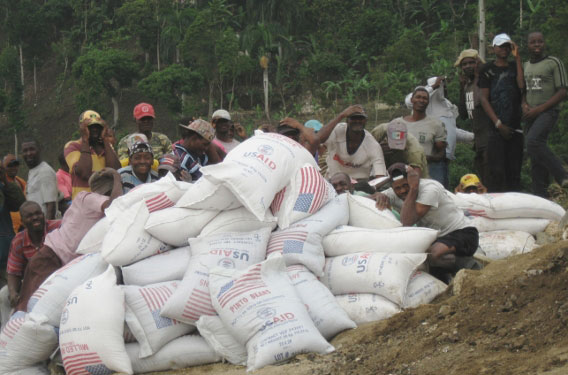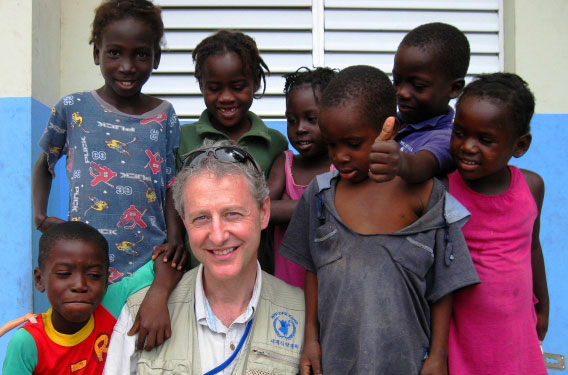High Stakes for Haiti
Some experts are looking beyond recovery to a new start for one of the world’s poorest countries, but skepticism abounds
By Leslie Macmillan
As Patrick Webb drove through the streets of Port-au-Prince just weeks after the earthquake on January 12, the mood was somber, and signs of frustration—including Haitians’ impatience with the international relief and peacekeeping efforts—were everywhere. Graffiti proclaimed: Aba ONG vole! (down with thieving NGOs) and Aba okypasion! (down with the military occupation).

Food aid isn’t always the answer. “Our concern is that food security should not just be about growing more food,” Patrick Webb says, “but that the food is the right food—nutritious and safe—and available to all who need it.” Photo: Courtesy of Patrick Webb
Haitians had heard about billions of dollars in aid pouring into their country, yet many were, and still are, without basic shelter and food. “Haiti is used to calling for relief after natural disasters, and it’s used to seeing very little of it get funded,” says Webb, the Friedman School’s academic dean, who was called in by the U.N. World Food Programme to assess the country’s nutrition and food security needs and help draw up a plan for reconstruction. “A little bit of fatigue sets in for them after a while,” he says.
Even before the earthquake, Haiti was broken. One of the world’s poorest countries, the island nation has struggled with political upheaval, health crises, natural disaster, deforestation and, more recently, gang violence. A daunting picture, no doubt, though some, like Webb, say the timing is right to rebuild the country—from scratch.
“Traditionally, that’s what reconstruction has been—to focus on immediate recovery and replacement of losses,” says Webb, who worked on emergency response and needs assessment after the 2004 tsunami in Asia and on other nutrition projects in Haiti. “This is the first time we were tasked with, ‘Don’t just stop there. Think blue sky. Give a 10-year vision of what it would take to fix Haiti.’ ”
In a process Webb likens to the wrangling over U.S. health-care reform, some 380 experts from Haiti and around the globe spent several weeks estimating what had been lost and fleshing out their recommendations, not just to repair buildings and roads, but to revitalize education, jobs, health and nutrition.
Their reconstruction plan, which sought $11.5 billion over the next decade, went to a donor conference in New York City on March 31, when Haiti received nearly $10 billion in pledges from 130 governments, including Brazil, France, China and the United States. The money will finance housing for 1.3 million people now living in tent cities, reconstruction of some 1,300 schools, new roads and other infrastructure and a program to boost agriculture so that Haiti can once again feed itself.
Now it comes down to implementation, and both donors and Haitians are skeptical. Will Haiti be able to assure donors that their money is going to be well spent, and will donors, who haven’t always come through in the past, pay up this time?
“Ten billion is not a lot of money to rebuild an entire country,” says Webb. “But will even that amount be forthcoming when [the nation’s] security could so easily go to hell in a handbasket?”
The Right Food
Of all Haiti’s challenges, food is at the top of the list. The country’s agriculture came to a standstill in the 1980s. Environmental degradation, an influx of food aid from the U.S. in the form of rice that was often sold at local markets and one of the lowest rice import tariffs in the Caribbean all combined to make it difficult for Haitian farmers to compete with the cheap imports.
Food security experts are saying only a complete reform of Haiti’s farming industry will break its dependence on imports and foreign aid, and now is the time to get it right. The country spends a staggering 80 percent of its revenue to import 50 to 60 percent of its food, yet its people are still going hungry.
“When you ‘cost’ the economic losses due to malnutrition, it’s almost equal to 30 percent of the gross national product,” says Webb, explaining that poor health, premature deaths, loss of income and low labor productivity are all byproducts of persistent malnutrition.
The nutrition portion of the plan represents roughly $700 million of an initial $4 billion requested for the first three years of reconstruction. It includes better treatment and prevention of malnutrition; a program that would pay 60 percent cash and 40 percent food in return for Haitians working on soil and water management projects, tree planting and expanding irrigation systems; and better emergency management, including a new early warning system for natural disasters and improved warehouses to store food for the next hurricane season and after harvests. Food warehousing is so poor now that a lot is lost to vermin and spoilage. The nutrition plan also includes a national school meal program that would rely on locally grown food—rice, beans and corn—to stimulate agriculture.
“Our concern is that food security should not just be about growing more food,” Webb says, “but that the food is the right food—nutritious and safe—and available to all who need it.”
Half of the nutrition team were representatives of the Haitian government. Webb had been working with the same group during the previous year, helping to draft national nutrition policy, which gave them something to build upon. Because of the prior working relationship, the planning process for nutrition went “very smoothly,” he says, which was not the case in some other sectors.

Patrick Webb with new friends in Haiti. Photo: Courtesy of Patrick Webb
“There are a lot of very loud intellectuals arguing that the solution is to grow mangoes for processing and export, or it should all be about textile industries or tourism—that’s the solution!—and when their project doesn’t get funded, they end up criticizing everything else. It’s too often like that,” says Webb.
He speaks from experience. Lining the walls of his office at Tufts are maps of North Korea, where he managed large-scale nutrition surveys and micronutrient programs, and Ethiopia, where he worked on famine relief in the 1980s.
Besides the problem of donors coming with their own agendas, Webb says, Haiti hasn’t always had much say in what’s offered as relief. Among the $2.4 billion sent to the island as humanitarian donations after the quake, were $10,000 worth of shoes, $30,000 worth of energy bars and vitamin water, $1 million worth of eye drops and 2,000 mobile phones, all given by the manufacturers of those goods. “Some of the donations are well-intentioned,” says Webb. But the companies benefit from tax breaks and good public relations, even when they send items that are not much use to a country struggling just to house and feed its people.
Webb recalls his experience after the tsunami in Aceh, Indonesia, a conservative Muslim society, where donations of revealing clothing and drugs and food past their expiration dates had to be destroyed. “That’s why there were giant pyres at the airport,” he says. “A lot of the stuff sent just gets burned.”
Agendas and Aftershocks
The nutrition team spent a nearly a month in Haiti, and Webb says signs of unease were everywhere. “The meetings we had were always disrupted by minor aftershocks that sent people running into the streets. Survivors were very, very jumpy,” he says. “Some of the government people refused to meet indoors and didn’t want to sleep with roofs over their heads.”
Team members brought their own tents and slept at a U.N. base dubbed Camp Charlie, which was surrounded by Nepalese and Brazilian peacekeeping battalions. Webb notes that the visitors lived in relative luxury compared to their Haitian counterparts.
He recalls that one day after their meetings had ended, the Haitian director of nutrition, a physician employed by the Ministry of Health, asked Webb if he wanted to see her “home.” It was a bedroll under a tree in a courtyard outside a demolished church that was surrounded by hundreds and hundreds of patients.
“She had to go to these high-level meetings and talk about plans and numbers, and then come back and treat all these people for free,” Webb says. “These were really sub-optimal conditions under which to expect our Haitian counterparts to be on top of their game.”
There are other Tufts people in Haiti, Webb says, including eight alumni who work for a variety of organizations, from UNICEF and World Vision to the U.N. special envoy’s office. As horrific as the circumstances are, Webb says there’s a strange poignancy to working in a disaster zone: “There’s a consciousness of the fragility of life that’s there 24/7. There’s contact with people pushed to the extremes. There’s putting your professional knowledge immediately to good effect.”
Poor Man of the Americas
Haiti was not always poor. A little more than 200 years ago, the country was one of France’s most prosperous colonies in the Caribbean. A bloody slave revolt in 1804 ousted the French occupiers, and Haiti became the first black country to gain independence. Webb says that sets it apart from other developing nations.
“It’s often the former colonial power that oversees development in newly independent countries, but France washed its hands of Haiti,” he says. “The Spanish- and English-speaking countries of the Caribbean did not see any common ground, and that left the U.S. as the donor of last resort because of proximity and the large Haitian immigrant population. But no donor has ever committed to nation-building in Haiti.”
Without a “patron” or a strong central government to oversee operations, a disaster like the earthquake can become a kind of free-for-all, says Webb, with everyone trying to grab a piece of the action. “You have freelance photographers trying to make a buck. Informal NGO types completely dazed by what they’re seeing. People who pay their own way down with no mandate, let alone training, and they’re taking up a camp bed and food and becoming a security burden,” he says.
“Haiti was founded as a pirate colony; it was a haven of French buccaneers,” says Webb, who notes a certain mercenary air still prevails. He recalls a cafeteria he went to some nights, where he would watch a steady stream of humanity coming in. “It was just a hole-in-the-wall kind of place, but it was open to the sky, and they had cold beers. So you’d be talking to a Japanese Red Cross person or maybe a Turkish surgeon, and then suddenly a group of American paratroopers would walk in with machine guns, and they’d be followed by Italian helicopter pilots with giant bowie knives strapped to their legs, followed by Chilean naval crews with a pistol on each hip, and I’d think it must have been just like this 200 years ago—people from all over the world, armed to the teeth, all mixing, all downing alcohol, all there with some kind of interest in Haiti.
“Haiti has always been the outlier,” Webb continues. “It’s the poor man of the Americas. It’s not the most malnourished—because other countries in Central America have greater nutrition problems—it’s not necessarily the poorest, but when you put it all together, it’s quite a mess. It’s going to take a long commitment, and donors are not always very good at committing for the long run.”
There is a lot at stake for Haiti, which in the long term, aid experts say, teeters on the brink of being a failed state. It could descend into the anarchy of a Somalia or Kosovo. In the short term, the hurricane season is approaching, and more than 10 percent of the population is living in tents without proper toilets. “Are the donors going to step up to the plate this time? It’s not a given,” says Webb. “But I hope so, because now’s the time.”
Leslie Macmillan can be reached at leslie.macmillan@tufts.edu.


